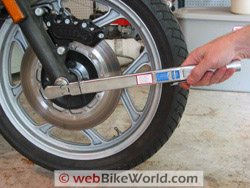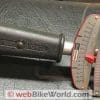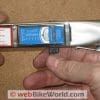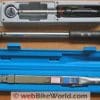A good torque wrench is an essential tool for even the most basic motorcycle maintenance and repair. It’s important to ensure that all of the fasteners on a motorcycle are tightened to specifications for reasons of safety and to maintain its original design integrity.
The the lightweight alloys used in motorcycles make it very easy to over-tighten and strip a nut or bolt, which can be an enormous (and expensive) problem.
Our advice: don’t guess! Know the correct torque settings for every nut and bolt and use a torque wrench.
Quality torque wrenches aren’t that easy to find. Probably the most commonly found torque wrenches in the U.S.A. are the Sears Craftsman brand. There are also various no-name brands that can be purchased from discount retailers, but since a torque wrench is such an essential and important piece of equipment that should last many, many years, our suggestion is to spend the extra money to buy a quality name brand.
Almost every motorcycle-related email discussion group will have regularly scheduled arguments among members arguing about which type of torque wrench is best. Any torque wrench is probably better than “Armstrong torque” (i.e., a guess), but we’ve used a few different torque wrenches around the webBikeWorld shop and our current favorite is this very easy to use split-beam type by Precision Instruments.
Precision Instruments have been making torque wrenches in the U.S.A. since 1938, and their products are highly regarded by machinists, engineers, mechanics and others. They make a huge variety of different types of torque wrenches in just about any configuration you could imagine, and it’s worth checking out their website if just to learn more about torque wrenches and their use.
It’s important to note that figures regarding torque wrench accuracy are usually valid from 20% of the full scale of the wrench’s rated torque capacity up to full scale.
For example, our model C2FR100F has a capacity of 20 to 100 ft. lbs. It is rated at ±4% accuracy, from 20% of its highest rating to the end of the scale. That means that the ±4% accuracy rate on this wrench is valid from 20 to 100 ft. lbs., in this case, across the entire range of the wrench.
For our purposes, that is, for working on motorcycles, torque wrenches basically come in four different configurations. The least expensive torque wrenches are the beam type. These have a pointer that indicates the torque as the fastener is tightened.
Although simple and virtually break-proof, they can be hard to use because it’s sometimes difficult to follow the indicator and to read the actual torque value. Also, a direct view of the pointer and scale is essential for correct application of torque, but it isn’t always possible or easy to get the wrench in a position that would make it easy to read when the fastener is upside-down, for example.
Next is the micrometer, or “click” type torque wrench. These typically have a handle that is turned to set an internal spring for the desired torque. Micrometer torque wrenches can be very accurate; some are rated at ±3% accuracy (i.e., about ±1 ft. lb. at a 30 ft. lb. setting). Micrometer-type torque wrenches can be used in both a clockwise and anti-clockwise direction (although torque wrenches should never be used to release a fastener).
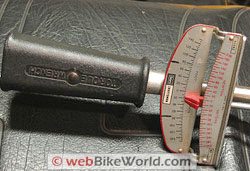
The downside is that micrometer torque wrenches must be set back to zero or to the “stop” setting after use to release the tension on the internal spring. This means that the handle must be cranked to the correct torque setting every time their used and then back to zero again when the job is complete.
We’ve found that some micrometer torque wrenches do not offer a good “feel” for when the desired torque is reached. In theory, they should click and release when the torque setting is reached, but depending upon the brand, the release point is not always obvious. This can lead to over-tightened fasteners.
A third type of torque wrench that is rarely seen in the casual garage is the dial type. These are some of the most accurate torque wrenches available for general mechanical use, with a ±1% accuracy. The amount of torque that is applied is not affected by where they are held, but the downside of the dial type is that the user must be in a position to read the dial.
The “split beam” type torque wrench is a relatively new technology. They’re easier to manufacture, they have fewer internal parts, they’re easier to set to the desired torque, and there’s no need to release it back to zero after the fastener is tightened. The Precision Instruments C2 Series Split Beam Click torque wrench shown here includes a head that flexes up to 15 degrees in either direction to help correctly locate the wrench in use, and it is also available with a fixed head.
The C2 is 43 cm long (16-15/16″) with an effective length (from the midpoint of the square drive to the midpoint of the handle in the center of the two knurled circumferential grip indicators) of 37 cm (14-31/64″). It weighs 1 lb. 9-5/8 oz., and the head has a nickel/chrome finish.
The body and handle of the wrench is made from a formed steel tube and it is plated with some type of low-luster silver-colored finish. Precision instruments claims that this torque wrench meets or exceeds ANSI B107.14M and the GGG-W-686C specification, which I believe is an older U.S. government federal or military specification. It has a ±4% accuracy rating.
The C2 Series is available in several different capacities, from inch-pounds to foot-pounds and also in Newton meters. Our model C2FR100F has a capacity of 20 to 100 ft. lbs.; that range covers a wide range of applications for motorcycle use. We also have a Sears Craftsman “Microtork” micrometer torque wrench with a 3/8″ drive, with a capacity of 25 to 250 inch pounds (~2 to 20 ft. lbs.) and 3.61 to 29.03 Newton meters for use with motorcycle fastener torque settings of under 20 ft. lbs. Sears claims that this wrench is accurate to within ±4% of the setting.
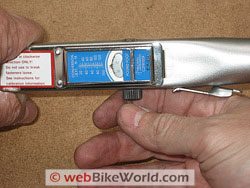

The scale is calibrated in 2 foot pound increments, making it slightly difficult to interpolate between the marks for odd number settings. A small conversion chart is located just above the indicator to convert foot pounds to Newton meters. Flip open the cover, set the torque, close the cover and it’s ready to use. There’s no need to zero out the setting after use.
The Precision Instruments C2 works smoothly and efficiently. There is a definite “click” when the correct torque setting is reached, and the wrench releases any further pressure on the fastener, which is crucial for a correct application of torque.
Some micrometer and all beam type torque wrenches can travel past the torque setting without a definite release, and they will continue to apply torque beyond the set value. This can be dangerous and is often the cause of stripped fasteners, especially at lower torque values of 10 to 20 ft. lbs., where it can be difficult to distinguish the click and release sound emanating from the torque wrench.
We’ve used a Sears Craftsman “Digitork” torque wrench for a number of years on webBikeWorld projects requiring over 20 foot pounds of torque, but we have never been satisfied with its quality or with our ability to distinguish when the torque setting was reached. Sears only offers a 90-day guarantee on their Digitork and Microtork torque wrenches, compared to the 1-year guarantee from Precision Instruments. Precision Instruments will also rebuild and recalibrate their torque wrenches, and they also sell rebuild kits.
Our Sears Craftsman Digitork torque wrench failed after only several uses, but it was out of warranty. It cost nearly as much as the torque wrench itself to send it back to Sears for repair and calibration. Precision Instruments also provides a certificate of calibration with each torque wrench, certifying it to be calibrated on equipment meeting Mil Std 45662A and ANSI/NCSL Z540-1-1994, with accuracy traceable back to the National Institute of Standards and Technology. The C2 model also meets the British BS6073:1988 and ISO 6789 standards for accuracy.
The Precision Instruments C2 is about twice the cost of the Sears Digitork, but we think that it’s easier to use, much more convenient because the torque settings do not have to be dialed back to zero, and it releases with a more definite click. Precision Instruments has many different types of torque wrenches, some with a ±1% accuracy rating. The C2 is a unique and well-made precision tool and comes in a nice fitted case. It should last a lifetime and it gives us confidence that our fasteners are torqued to the correct settings.
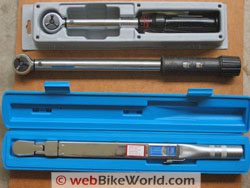


| Product Review: C2 Split Beam Torque Wrench by Precision Instruments | |
| Available From: Precision Instruments Made in: U.S.A. |
Suggested Retail Price: $157.95 w/free shipping from Toolsource.com |
| Review Date: September 2004 | |
Note: For informational use only. All material and photographs are Copyright © webWorld International, LLC – 2000-2011. All rights reserved. See the webBikeWorld® Site Info page. NOTE: Product specifications, features and details may change or differ from our descriptions. Always check before purchasing. Read the Terms and Conditions!
Owner Comments and Feedback
Not all comments will be published (details). Comments may be edited for clarity prior to publication.


